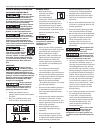
9
www.chpower.com
GW4500
Welder Operation
(Continued)
5. Tighten the set screw, securing the
cable in place.
6. Slide the insulated handle onto
the electrode holder and tighten
the phillips head screw. Do not
overtighten the phillips head
screw. Overtightening will
damage the insulated handle.
DINSE PLUGS (SEE FIGURE 3)
1. Strip 1/2 inch of insulation from the
opposite end of the welding cable.
2. Insert this end of the welding cable
through the dinse plug boot and
slide the bare wire into the wire
sleeve.
3. Insert the welding cable/wire sleeve
assembly into the back of the dinse
plug.
4. Tighten the set screw, securing the
cable in place.
5. Slide the boot over the hex portion
of the dinse plug.
6. Repeat for the other lead.
Welding
1. Verify that the surfaces of metals
to be joined are free from dirt,
rust, paint, oil, scale or other
contaminants. These contaminants
make welding difficult and cause
poor welds.
All persons
operating this
equipment or in the area while
equipment is in use must wear
protective welding gear including: eye
protection with proper shade (minimum
shade 10), flame resistant clothing,
leather welding gloves, and full foot
protection.
If heating, welding,
or cutting materials
that are galvanized, zinc plated,
lead, or cadmium plated refer to the
General Safety Information Section for
instructions. Extremely toxic fumes are
created when these metals are heated.
2. Connect the work clamp to the
work piece. Make sure the contact
is on bare metal and not obstructed
by paint, varnish, corrosion, or non-
metallic materials.
3. Insert the exposed part of the
electrode (the end with no flux)
into the jaws of the electrode
holder.
4. Set the amperage adjustment knob
to the proper amperage for the
electrode diameter. Refer to the
chart on the front panel for proper
electrode current settings.
The electrode holder
and rod are
electrically “live” (current potential)
when the engine is running.
5. Position the electrode to begin
weld, lower the welding helmet or
position the hand shield, and strike
an arc. Adjust weld amperage as
needed.
6. When finished welding, turn
engine off and store unit properly.
DUTY CYCLE / THERMOSTATIC
PROTECTION
Welder duty cycle is the percentage of
actual weld time that can occur in a ten
minute interval. For example, at a 10%
duty cycle, actual welding can occur for
one minute, then the welder must cool
for nine minutes.
Internal components of this welder are
protected from overheating with an
automatic thermal switch.
Maintenance
INFREQUENT USAGE
If the welder / generator is used
infrequently, starting difficulty may
occur. To help prevent this, the
welder / generators should be run for
approximately 30 minutes per week.
STORAGE
If the welder / generators is not to be
used for extended periods of time,
the following pre-storage procedures
should be performed:
1. Make sure engine oil is filled to the
proper level.
2. Drain all fuel from the tank, lines,
carburetor and fuel valve.
3. Remove the spark plug, and pour
approximately one teaspoon of oil
into the spark plug hole.
4. Pull the starter cord several times
to spread the oil throughout the
cylinder.
5. Slowly pull the starter cord, until
resistance is felt. This indicates that
the piston is moving upward on the
compression cycle, and the intake
and exhaust valves are closed. (The
piston pushes a small amount of
air from the spark plug hole on
compression.)
6. Use of fuel stabilizers or anti-
gumming agents in the fuel system
can help prevent the build up of
gum and varnish.
Whenever the welder / generator is
stored, be sure that the fuel shut-off
valve is in the closed position.
Refer to the engine manual that
accompanies this unit for instructions
regarding maintenance of engine
components.
Never tamper with
engine speed
settings or welder / generators
frequency settings. Any governor
adjustments should be made by
qualified personnel only.
WELD CABLES
1. Check condition of weld cables and
immediately repair or replace any
cables with damaged insulation.
2. Check condition of electrode holder
insulating pieces and immediately
replace cracked or missing parts.
EVERY 3 MONTHS
Replace any unreadable labels on the
welder. Use compressed air to blow
all dust and lint from the ventilation
openings.
Dinse Plug
Boot
Set Screw
Wire Sleeve
Welding
Cable
Figure 3


















